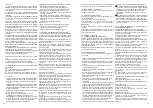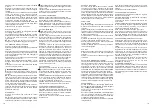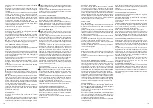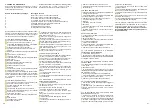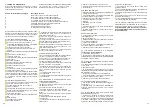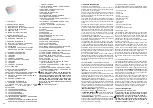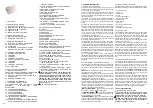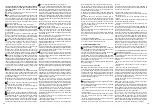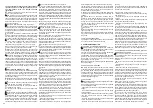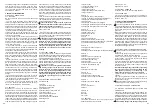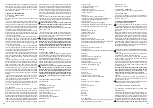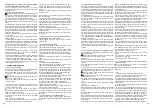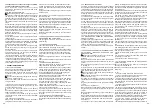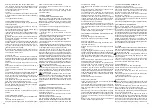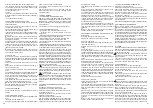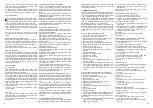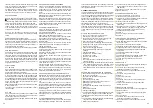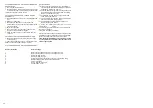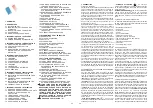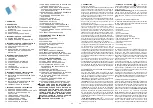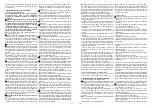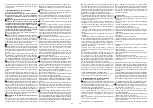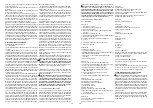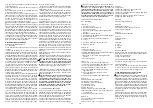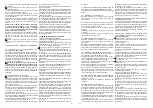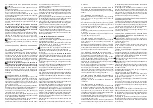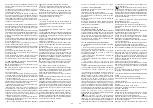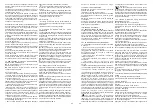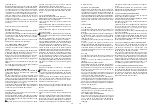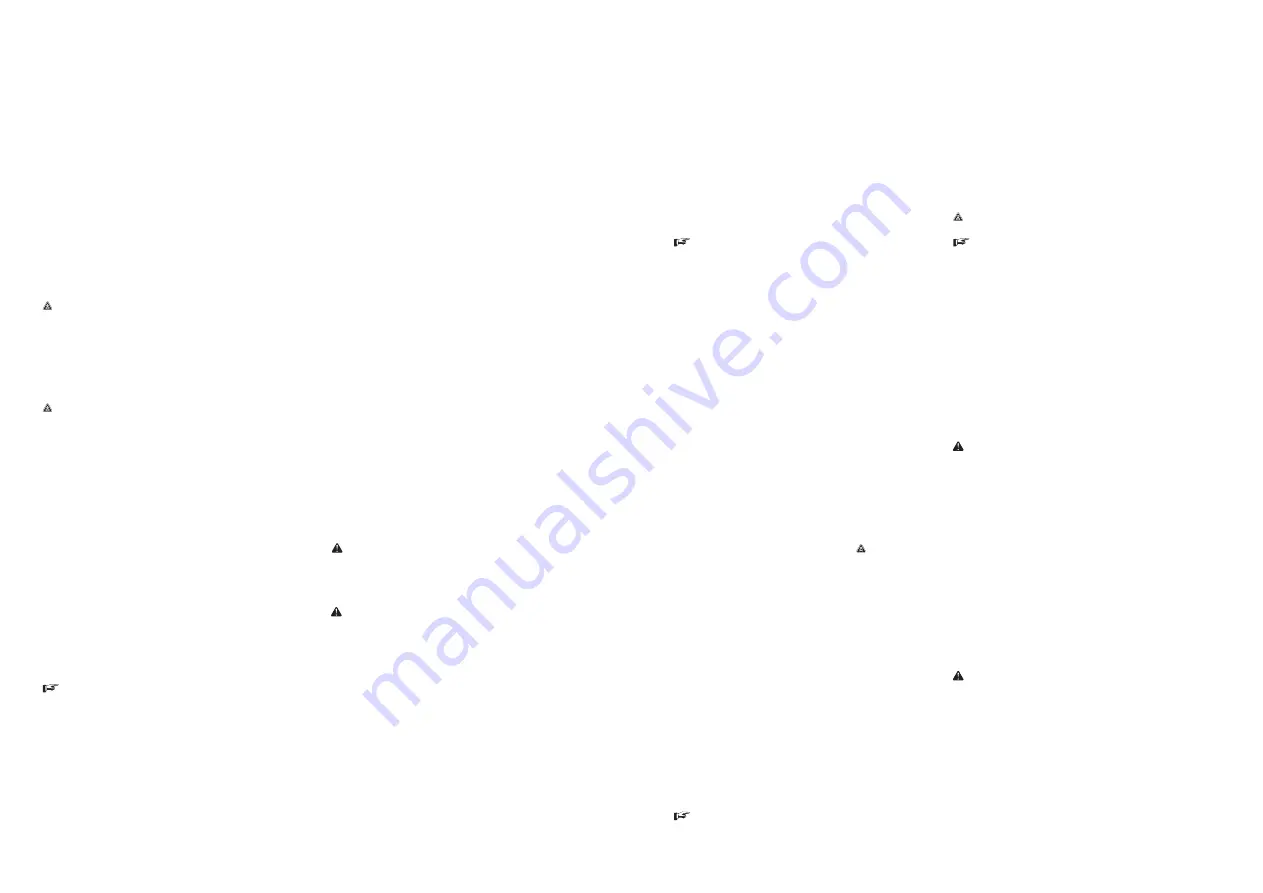
water to prevent foam from being created inside.
Do not leave the water hose unattended and insert
it completely into the tank: the hose might move and
get sensitive parts of the machine wet.
Close the tank cover.
To drain:
Open the valve located at the bottom of the machine
in the back and wait until the tank has been completely
emptied.
Fully tighten the drain valve.
7.5 DRAINING THE RECOVERY TANK
The dirty water must be drained in accordance with
national regulations.
The user is completely responsible for ensuring
compliance with such rules.
After the detergent solution is finished, always empty
the recovery tank before filling it again.
In general, the recovery tank can be emptied whenever
required, and even during intermediate phases of the
work cycle.
Always empty the recovery tank before lifting it to
avoid health problems for operators and to avoid
damaging the machine.
The recovery tank volume is higher than the detergent
solution volume, therefore a potentially dangerous
situation for the suction motor should never occur. In
any case, a safety float turns off the suction motor if
the dirty liquid level is too high.
If water or foam starts leaking from under the tanks
for any reason, immediately turn off the suction motor
and empty the recovery tank.
To drain the tank:
Drive the machine to a suitable location to drain the
dirty water and preferably near a toilet or a sewer drain
(comply with the national regulations for waste water
disposal).
Turn off the machine and remove the key from the
panel.
Detach the drain hose from the hook and, keeping it
high, unscrew the plug.
Lower the drain hose toward the selected drainage
point.
The emptying operation can be interrupted quickly and
whenever required just by raising the drain hose.
Check the quantity of residual dirt in the tank and, if
necessary, clean the interior through the inspection
hole, lifting the cover.
Fully tighten the drain hose with the screw plug and
hang it on the support behind the machine.
The top cover of the tank and the drain hose plug
must be airtight, otherwise the subsequent pressure
loss will reduce drying efficiency.
7.6 SEAT ADJUSTMENT
Check that the seat is in a stable position and firmly
secured.
7.7 DRIVING THE MACHINE
Select the running direction using the Forward/Reverse
lever.
Insert and turn the ignition key.
Using the right foot lightly press the accelerator pedal
and drive the machine to its destination.
Turn off the machine and remove the keys from the
control panel.
The running direction can be changed using the
forward/reverse lever, even while pressing on the
accelerator pedal.
7.8 WORK METHOD
7.8.1 PREPARATION AND WARNINGS
Remove any loose solid residue from the surface to be
treated (using suitable tools, such as vacuum cleaners,
sweepers, etc.). It this is not done, the solid dirt might
prevent the squeegee from operating correctly, reducing
drying efficiency.
This machine can driven only by trained personnel.
7.8.2 OPERATING CONTROLS
Ignition key, to turn the machine on and off.
Direction lever, to select forward or reverse
movements.
Speed regulator, to select the maximum advancement
speed when the pedal is fully depressed.
Brush switch, to turn on the brush rotation motor.
Suction switch, to turn on the suction motor.
Emergency switch, to cut off/restart all programmed
work operations.
Right advancement pedal, to start moving the machine.
Solution flow adjustment lever, to regulate the quantity
of detergent solution to be applied on the floor.
Battery charge control, the sequence of lights
progressively turns off until the battery is discharged.
When the red light turns on, turn off the brush motor,
close the solution supply, finish drying the small residual
moisture and go to the battery charging area to charge
the battery. If these operations are not carried out, the
machine will automatically deactivate the brush motor
and it will only be possible to move the machine. In this
situation if the machine is not stopped right away, all
functions will be cut off automatically, and the machine
will have to be moved by hand.
The batteries may be irreparably damaged if the
residual charge level drops too low (see the battery
operating manual). Do not force the battery discharge
beyond the safety limits, turning the key off and on or
in any other manner.
When an abnormal situation occurs, such as when
the machine doesnt have enough power and the safety
devices dont trip, stop immediately: follow the
instructions in the troubleshooting section and contact
a specialised worker to check the discharge control
devices.
7.8.3 DIRECT SCRUBBING OR FOR SLIGHTLY DIRTY
SURFACES
Scrubbing and drying in a single pass.
Prepare the machine as previously described.
Select the forward direction using the direction lever.
Insert and turn the key.
Activate the suction motor, the brush motor and the
detergent solution supply.
Lower the brushes and the squeegee.
Use the detergent adjustment lever to regulate the
solution outlet flow (depending on advancement speed).
Lightly press the advancement pedal and check that
all systems are working.
Fully depress the accelerator to increase the work
speed.
Adjust the maximum advancement speed and the
detergent solution flow as required.
The steering wheel is similar to a car steering wheel:
it can be used to turn the machine around itself by
steering all the way to one side. § During these
operations, the rear of the machine moves slightly
outward: reduce the speed to avoid brusque direction
changes and impacts against walls or other objects.
Use the brake to stop the machine.
To avoid damage to the surfaces being treated, the
brush motor will stop automatically about 2 seconds
after the advancement pedal has been completely
released.
Never use the machine without the detergent
solution: the floor might be damaged.
7.8.4 INDIRECT SCRUBBING OR FOR VERY DIRTY
SURFACES
Scrubbing and drying in various passes.
Prepare the machine as previously described.
First set of operations:
Select the forward direction using the direction lever.
Insert and turn the key.
Activate the brush motor and the detergent solution
supply.
Lower the brushes.
Use the detergent adjustment lever to regulate the
solution outlet flow (depending on advancement speed).
Lightly press the advancement pedal and check that
the brushes and solution feed system are working.
Fully depress the accelerator to increase the work
speed.
Adjust the maximum advancement speed and the
detergent solution flow as required.
The steering wheel is similar to a car steering wheel:
it can be used to turn the machine around itself by
steering all the way to one side. During these
operations, the rear of the machine moves slightly
outward: reduce the speed to avoid brusque direction
changes and impacts against walls or other objects.
Allow the detergent solution to work on the dirt according
to what is indicated in the information relative to the
detergent used.
Use the brake to stop the machine.
Second set of operations:
Follow the steps described in the previous section
Direct Scrubbing (7.8.3).
To avoid damage to the surfaces being treated, the
brush motor will stop automatically about 2 seconds
after the advancement pedal has been completely
released.
When moving in reverse, the squeegee will lift and
suction will be deactivated automatically. After changing
direction (forward direction), the squeegee and the
suction will automatically return to their previous
condition.
Never use the machine without the detergent
solution: the floor might be damaged
7.8.5 POST-SCRUBBING OPERATIONS
Cut off the supply of detergent.
Lift the brush unit and turn off the brush motor.
After having completely dried any traces of water on
the surface, wait a few seconds and then lift the
squeegee and turn off the suction motor.
Move to a suitable location to drain the tanks (as
described in 7.4 and 7.5).
Empty and clean the tanks (see sections 7.4 and 7.5).
Turn off the machine using the key and remove it from
the control panel.
If necessary, charge the battery (see the relative section).
8. MAINTENANCE INFORMATION
Turn the key, remove it from the control panel and
disconnect the battery from the machine wiring.
All work on the electrical system as well as all
maintenance and repair operations (especially those
not explicitly described in this manual) should be carried
out only by authorised service centres or by specialised
technical personnel who are experts in the sector and
in the pertinent safety regulations.
Performing regular maintenance on the machine, and
carefully following the manufacturers instructions, is
the best guarantee for obtaining the best performances
and extended machine service life.
8.1 TANKS
Drain the two tanks as described in the relative sections.
Remove any solid dirt by filling and draining the tanks
until all dirt has been eliminated: use a washing hose
or similar tool to do this.
Water hotter than 50°, a high-pressure cleaner or
excessively powerful sprays may damage the tanks
and the machine.
Leave the covers of the tanks open (only while the
machine is not being used) so that they can dry and
thus prevent the formation of foul odours.
8.2 SUCTION HOSE
Detach the suction hose from the squeegee.
Detach the pocket and access the interior to pull out
the complete suction hose.
Now you can wash the hose and remove any
obstructions.
Firmly insert the suction hose inside the rear pocket,
in the special tank opening.
Firmly insert the hose on the squeegee body.
8.3 SQUEEGEE
Do not handle the squeegee with bare hands: wear
gloves and any safety clothing needed to carry out the
operation.
Detach the squeegee from the machine and clean it
under running water using a sponge or a brush.
Make sure that the compartment cover is tightly closed
after cleaning: the machine may not dry efficiently if the
cover is not properly closed.
Check the efficiency and the wear on the strips in
contact with the floor. They are designed to scrape the
film of detergent and water on the floor and to isolate
that portion of the surface to enhance the vacuum of
the suction motor: this ensures that the machine will
dry very efficiently. Working constantly in this manner
30
31
Summary of Contents for KF75B
Page 4: ...4 5 D C E F...
Page 5: ...4 5 D C E F...
Page 6: ...7 G H I L M 6...
Page 7: ...7 G H I L M 6...

